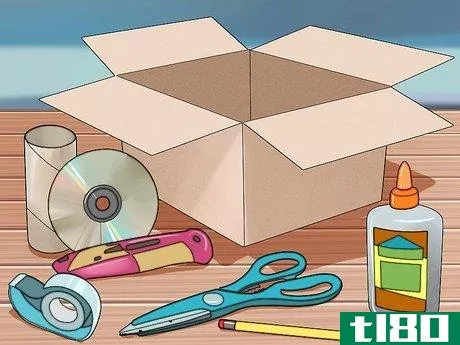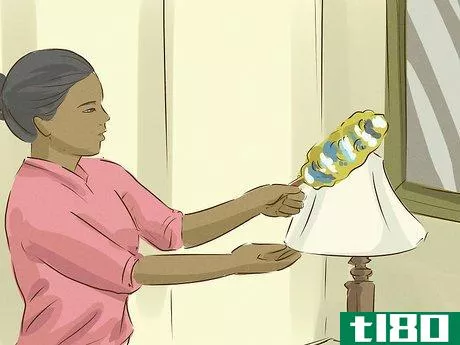制作彩色蜡烛火焰
你有没有想过给蜡烛的火焰涂上颜色?我收到了几个关于如何实现这一目标的问题,包括以下电子邮件:
 Hi, I just posted this question to the forum but I am also interested in your take on it. I read the article about colored fire and decided to try to make a candle with a color flame! First I tried dissolving the chems you suggested in the article (such as cupric chloride) into water until it was fully concentrated, and soaking some wicks overnight. After drying the wicks I found that on their own they do burn with a pretty flame (well, some of the chemicals), but once I tried adding wax to the mixture the natural color of the wax burning completely took away any desired effects. Next I tried grinding up the chems into a fine powder and mixing as uniformly as possible with the wax. This was also unsuccessful and resulted in sporadic and weak color at best and often wouldn't even stay lit. Even when I could keep the particles from sinking to the bottom of the molten wax, they still [do] not burn correctly. I am convinced that in order to make a functioning candle with a color flame it is necessary to fully dissolve the salts and minerals listed in the article into the wax. Obviously the salts do not naturally dissolve and this got me thinking that maybe an emulsifier is necessary? Does that make sense? Thanks!
Hi, I just posted this question to the forum but I am also interested in your take on it. I read the article about colored fire and decided to try to make a candle with a color flame! First I tried dissolving the chems you suggested in the article (such as cupric chloride) into water until it was fully concentrated, and soaking some wicks overnight. After drying the wicks I found that on their own they do burn with a pretty flame (well, some of the chemicals), but once I tried adding wax to the mixture the natural color of the wax burning completely took away any desired effects. Next I tried grinding up the chems into a fine powder and mixing as uniformly as possible with the wax. This was also unsuccessful and resulted in sporadic and weak color at best and often wouldn't even stay lit. Even when I could keep the particles from sinking to the bottom of the molten wax, they still [do] not burn correctly. I am convinced that in order to make a functioning candle with a color flame it is necessary to fully dissolve the salts and minerals listed in the article into the wax. Obviously the salts do not naturally dissolve and this got me thinking that maybe an emulsifier is necessary? Does that make sense? Thanks!回答
如果制作彩色蜡烛火焰很容易,这些蜡烛很可能会出售。是的,但只有当蜡烛燃烧液体燃料时。我想你可以把一个灯芯连接到一个充满金属盐燃料的酒精灯上,制造出一个燃烧彩色火焰的酒精灯。这些盐可以溶解在少量的水中,可以与酒精混合。有些盐直接溶于酒精。使用燃油也有可能达到类似的效果。我不确定蜡烛是否也能起作用。浸泡灯芯会产生彩色火焰,就像你燃烧被金属盐浸泡过的纸或木头一样,但蜡烛的灯芯燃烧非常缓慢。大部分火焰是由汽化蜡燃烧产生的。
有人试过用彩色火焰做蜡烛吗?对于发送此电子邮件的读者,您是否有任何建议或关于哪些内容有效/无效的提示?
评论
汤姆说:
I too tried using paraffin wax but to no avail. I searched around and US patent 6921260 is probably the best description on the previous art and its own design, careful reading of the patent reveals that it should be possible to make colored flame candles at home if you know what you’re doing.阿诺德说:
There is an old pdf article dated Dec 26, 1939 entitled Colored Flame Candle. In it William Fredericks used petroleum jelly as a fuel source with the mineral salt suspended in it. Although I haven’t built the whole project, I did suspend copper chloride in petroleum jelly, and it burned very nicely. A nice blue flame. You have to play with the ratios. As I see it, there are two approaches. A. Drill an existing candle from the top, and fill the hole with warmed jelly, or B. Follow the instructions in the article by building a candle around an inner core of jelly. But I was asked a question which I need to answer: Is breathing the smoke of colored flame candles healthy? i.e. copper, strontium, potassium Perhaps we can put our heads together on this project. I would like to get the colored flame candle project started. I saw that you have tried some things, but found they didn’t work. I would ask you not post this information yet. I would rather think this through with you and present the final project, rather than to publish the raw thinking of it. On the net I have found very chemically complicated candles (ethanolamine etc.) I mixed copper I chloride with petroleum jelly, put a wick in it, and it burned very nicely blue. There was some moisture there, so it did stink a bit. I read in one of the patent papers online that one of the problems is the amount of carbon particles in a candle flame. The suggestion was to use a palladium, vanadium or platinum chloride as a catalyst/accelerant (absorbing a small amount of this material on the wick) to increase the temperature. Not exactly cheap or readily available. But supposedly the orange flame is gone. The other alternative is to burn smaller chain organic compounds, like citric acid or benzoic acid. I haven’t tried these. Faerie flames advertises their candles are not paraffin, but crystals. Perhaps you have some ideas on other smaller molecules. I find that alcohol flames color very nicely, but paraffin is just not very hot burning. Yes, I am knowledgeable in chemistry with a B.Sc. in chemistry.切尔斯说:
I am trying to make a color flame candle myself. I think the first step would be producing a candle that burns with a light blue/luminous flame, you need to get rid of the yellow. To do this you need a fuel that has a low carbon content. Things like paraffin and stearin burn yellow due to their high carbon content. I don’t think it’s possible to make a good color flame candle with paraffin. A lot of patents seem to recommend Trimethyl Citrate. It’s a waxy/crystalline solid that burns a light blue. But I can’t find a place to get it, unless I want to buy it in industrial quantities! Does anyone know where I can find trimethyl citrate? It’s used as a food additive and cosmetic ingredient so I figure it isn’t toxic.Amber说:
I see a lot of soy candles on the market. I am wondering if perhaps this may work with soy or beeswax?布莱恩说:
I have had a little success making a bluish candle flame by using copper desoldering braid. It makes a surprisingly good candle wick. In order to get the color, however, I first heated it up to melt out the impregnated rosin. I then put it in saltwater, put another wire in saltwater (pretty much any metal except aluminum), made sure they didn’t touch, and attached a 9 V battery to the wires—negative to the bare wire, positive to the copper braid. Within seconds, tiny bubbles will come off the – wire and blue-green stuff will form on the + braid. Leave it in for a while. Most of the green stuff will come off the braid into the water. The stuff is most likely copper chloride, formed from the chloride in the salt. After the braid is green (but before it falls apart), pull it out, trying not to knock off too much stuff. Dry it, preferably by hanging. Then try that as a wick. I’ve only tried limited experiments, so your mileage may vary.埃里克说:
I’m working on Bryan’s idea of using desoldering braid as a wick. I’ve had limited success so far. The theory is good it seems, but the main problem I’ve had is that the "wick" doesn’t seem to be very good at drawing the molten wax up to the flame. The longest I’ve been able to keep one lit is about thirty seconds. I’m thinking that either I did not allow the wick to remain in the saltwater solution long enough or perhaps I might benefit from a different variety of wax or possibly weaving the braid together with a more traditional wick.普里扬卡说:
take 1.5 cups of water and add 2 tbsp of salt (NaCl). dissolve 4 tbsp of borax. Then dissolve Add 1 tsp. of one of the following chemicals for colored flames: strontium chloride for a brilliant red flame, boric acid for a deep red flame, calcium for a red-orange flame, calcium chloride for a yellow-orange flame, table salt for a bright yellow flame, borax for a yellow-green flame, copper sulfate (blue vitriol/bluestone) for a green flame, calcium chloride for a blue flame, potassium sulfate or potassium nitrate (saltpeter) for a violet flame or Epsom salt for a white flame.David Tran说:
Wouldn’t the NaCl contaminate the flame with yellow and overpower the other colors?蒂姆·比尔曼说:
Priyanka: Check your colors. Boric acid burns green, calcium chloride burns orange/yellow, etc. I can make solutions of boric acid (which can be bought at Ace Hardware-type stores 99% pure as a cockroach killer) and strontium chloride (an additive from pet stores for saltwater fish tanks) which burn nicely in a mixture of acetone and rubbing alcohol, but those solutions do not mix with melted candle wax (because it is non-polar.) The next thing I was going to try was finding an emulsifying agent that was safe to burn (i.e., probably not soap) to make a semisolid colloid with the compounds dissolved in the wax. Any ideas on what my emulsifier could be? What can make oil and water mix besides soap?米娅说:
For colored flames the element burn: Lithium = Red Potassium = Purple Sulfur = Yellow Copper/copper oxide = Blue/Green I would just look at the elements and chemicals that they use in fireworks because those burn with different colors.- 发表于 2021-09-11 17:50
- 阅读 ( 314 )
- 分类:化学
你可能感兴趣的文章
如何制作香烛
通过**自己的香味蜡烛,便宜地装饰你的房子(或者给朋友做很棒的礼物)。教程网站WikiHow解释说,你需要石蜡、硬脂酸、玻璃、带灯芯支撑物的灯芯、香油、金属倒罐、温度计、色块,以及一个放在沸水平底锅上的双锅/金属...
- 发布于 2021-07-30 05:06
- 阅读 ( 182 )
科学计划图片库
...从绿色粘液到在黑暗中发光的各种颜色的粘液。当你自己制作黏液时,你通常会将硼砂和胶水混合。如果你使用半透明蓝色或透明胶水,你可以得到半透明粘液。如果你用白胶,你会得到不透明的黏液。改变胶水和硼砂的比例,...
- 发布于 2021-09-04 12:10
- 阅读 ( 218 )
如何制作罗马蜡烛烟火(make a roman candle firework)
...。通常,电荷通过一层粘土或锯末相互分离。以下是如何制作自制罗马蜡烛的说明。 关键外卖:如何制作自制罗马蜡烛 罗马蜡烛是向空中发射火球的烟火。每个火球都是一个独立的恒星,由一层粘土将其与下一颗分开。 虽...
- 发布于 2021-09-06 23:25
- 阅读 ( 270 )
变色化学实验
...变化而变化。不需要危险的化学物质,而且你可以用果汁制作自制的pH值纸,当用来测试家用或实验室的化学物质时,pH值纸会变色。 制作红甘蓝pH指示剂 自制pH纸 用卷心菜汁做绿鸡蛋 蓝色瓶子颜色变化(其他颜色也有...
- 发布于 2021-09-07 00:00
- 阅读 ( 275 )
万圣节最佳化学项目
...需要一把刀或一支蜡烛就能创造出这个诡异的南瓜灯脸。制作一个万圣节用的磷光南瓜出奇的快而且容易。 制造假血 我想我们都同意在万圣节庆祝活动中最好使用假血。当然,你可以买假血,但是如果你自己做的话,...
- 发布于 2021-09-15 12:01
- 阅读 ( 263 )
用烟点蜡烛
你知道你可以用另一支蜡烛点燃一支蜡烛,但是如果你吹灭其中一支,你知道你可以从远处重新点燃它吗?在这个技巧中,你将吹灭一支蜡烛,然后通过使火焰沿着烟的路径传播来重新点燃它。 如何做旅行火焰把戏 点燃蜡...
- 发布于 2021-09-19 06:44
- 阅读 ( 170 )
蜡烛能在零重力下燃烧吗?
蜡烛可以在零重力下燃烧,但火焰却大不相同。火在太空和微重力中的行为与在地球上不同。 微重力火焰 微重力火焰在灯芯周围形成一个球体。扩散为火焰提供氧气,使二氧化碳离开燃烧点,从而减慢燃烧速度。微重力下...
- 发布于 2021-09-21 07:23
- 阅读 ( 230 )
蜡烛燃烧时会发生什么
当你点燃蜡烛时,你燃烧后得到的蜡比开始时少。这是因为蜡在火焰中氧化或燃烧,产生水和二氧化碳,这些水和二氧化碳在蜡烛周围的空气中消散,产生光和热。 蜡烛燃烧 蜡烛蜡,也叫石蜡,由氢原子包围的碳原子链组...
- 发布于 2021-10-14 05:28
- 阅读 ( 261 )
什么是锥形蜡烛?(taper candles?)
... 制作锥形蜡烛的方法有很多种。一些公司用传统的方法制作锥度,即浸渍法。浸蜡烛是通过反复将一根灯芯浸入一罐蜡中制成的,大多数生产商都会将一根超长的灯芯循环...
- 发布于 2021-12-16 16:43
- 阅读 ( 187 )
什么是还愿蜡烛?(votive candles?)
...烛。它们点燃后会融化成油,这就要求它们在为此目的而制作的小玻璃杯或杯子中燃烧。 ...
- 发布于 2021-12-17 12:06
- 阅读 ( 238 )















